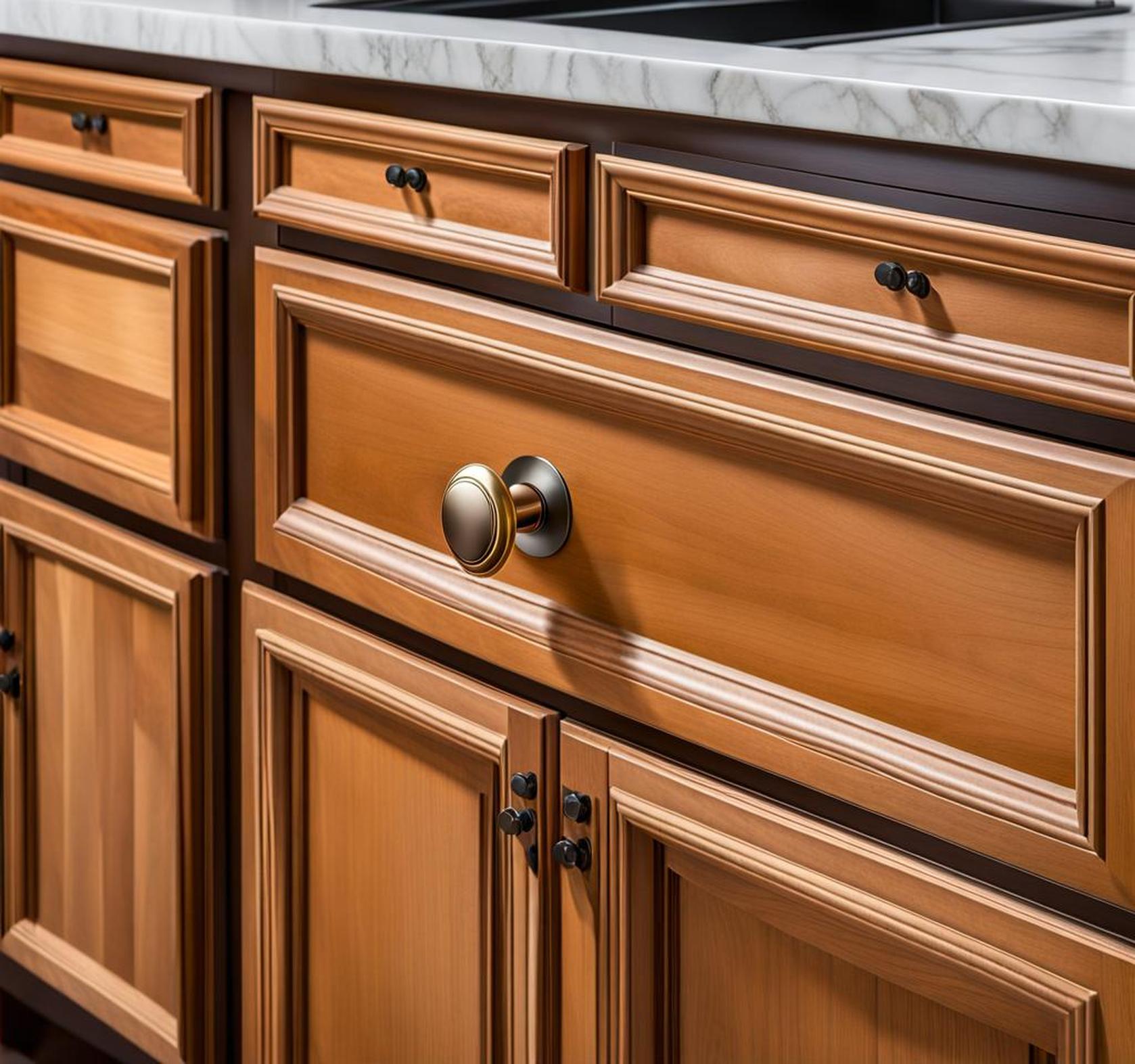Installing new hardware is one of the easiest ways to update the look of your kitchen cabinets. But beyond just aesthetics, proper knob and pull placement also improves functionality. Positioning handles in the right spots allows for better leverage and ease of opening. And a uniformly aligned hardware layout creates visual harmony.
Types of Cabinet Hardware
The first step is deciding which style of hardware complements your kitchen design best. The three main options are knobs, pulls, and handles.
Knobs
Knobs are round handles that attach to cabinets with a single screw. They work well on both doors and drawers, but particularly smaller drawers.

The benefits of using knobs include:
- Classic, versatile appearance
- Ease of use – easy to grip and turn
- Compact size suitable for narrow spaces
- Allow for patterns and mixes of styles
We recommend using knobs for most standard drawer applications. They can also work on cabinet doors, but typically pulls or handles are better suited for larger doors.
Pulls
Pulls are long handles oriented vertically that attach to cabinets with two screws. They come in a few styles:
- Standard pulls – long rectangular shape
- Cup pulls – curved shape, like an upside down “U”
- Finger pulls – small flared shape on top of door
The benefits of cabinet pulls include:
- Sleek, modern look
- Added grip and leverage – good for heavier doors/drawers
- Greater visual impact
Pulls work best on larger cabinet doors and wide drawers where more leverage is needed.
Handles
Handles come in various curved shapes like a half moon, arch, or loop. They function similar to pulls by providing grip leverage but allow for more decorative styling.
Benefits of using cabinet handles include:
- Unique decorative shapes
- Ergonomic curves fit hand nicely
- Finishing accent that enhances other hardware
- Can be combined with knobs or pulls
Handles look great on cabinet doors of all sizes. Mix and match with knobs and pulls to create your own custom hardware aesthetic.
Placement Guidelines by Hardware Type
With your hardware selected, now it’s time to learn guidelines for properly installing knobs, pulls, and handles.
Knob Placement
Proper knob placement comes down to two key factors – number of knobs and positioning.
One vs Two Knobs
- Small, narrow drawers only need one centered knob
- For larger drawers, install two knobs evenly spaced apart horizontally
Centered Vertically and Horizontally
- Visualize drawer as three columns and three rows
- Place single knob in middle of 2nd column and 2nd row
- For lower drawers, move up to middle of 1st row and 2nd column
- Space two knobs evenly across 2nd row
Be sure to keep knob spacing and alignment consistent for a uniform look. For cabinet doors, center knobs both vertically and horizontally.
Pull Placement
There are a few techniques for properly positioning pulls.
Standard Pulls
- Divide door or drawer face into a 3×3 grid of equal rectangles
- Install pull centered through 2nd row, 2nd column
- Can shift up to 1st row for extra leverage
Cup Pulls
- Position on upper third of door or drawer height
- Center horizontally in middle column
Finger Pulls
- Install on top edge of door or drawer
- Center horizontally in middle column
Handle Placement
Guidelines for handle installation include:
- Consistent spacing between handles on doors/drawers
- Position vertically based on door/drawer height
- Curved and loop handles centered horizontally
- Lower arched handles to align with cabinet style
Make sure spacing allows proper clearance between handles and cabinet edges.
Achieving Visual Harmony
Equally important as following the placement guidelines is ensuring all knobs and pulls have a cohesive, uniform look.
Consider these tips for visual harmony:
- Maintain consistent spacing between knobs/pulls across cabinets
- Align hardware in straight vertical and horizontal lines
- Only mix knob and pull styles intentionally, not randomly
- Limit mix to 2-3 finishes or styles at most
- Use same style hardware for paired cabinet doors/drawers
Proper alignment creates a clean, polished look. But don’t be afraid to break alignment intentionally to create visual interest through hardware patterns or groupings.
Special Considerations
While the standard guidelines work for most kitchens, you may need to adapt placement in certain situations.
- Raise or lower height for cabinets/drawers far out of the norm
- Adjust horizontal spacing to fit handles on narrow cabinets
- Lower hardware height to accommodate children or wheelchair users
- Reposition hardware on misaligned cabinets for optical illusion
See what works best in your unique kitchen. The goal is both aesthetics and functionality.
Installing kitchen cabinet knobs and pulls may seem simple, but the right placement requires careful planning. Following the standard guidelines for your chosen hardware ensures everything functions and looks its best.
By centering and aligning knobs and pulls accurately, you create a cohesive look that enhances your entire kitchen design. And proper leverage placement improves ease of access. Adjust as needed to accommodate your specific cabinets and functional needs.
Beyond placement, also consider factors like size, style, and finish. But start with getting the knobs and pulls positioned correctly as the foundation.
You can achieve the kitchen of your dreams with the help of some careful planning.
